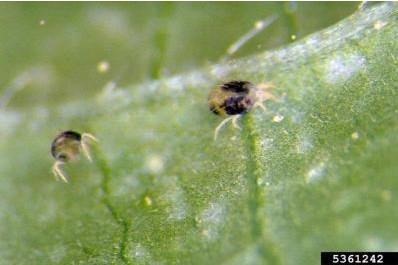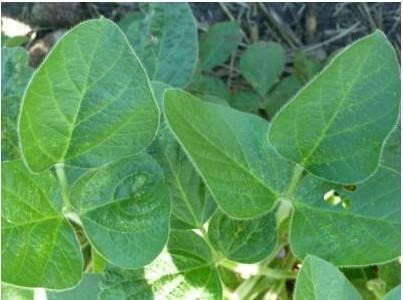By Erin Hodgson
Twospotted spider mites have been spotted in fields across much of Iowa already this summer, as much of Iowa is in moderate or severe drought (D1-D2, US Drought Monitor). I encourage you to scout for twospotted spider mites in crops. Twospotted spider mites can increase whenever temperatures are greater than 85°F, humidity is less than 90 percent, and moisture levels are low. These are ideal conditions for the twospotted spider mite and populations are capable of increasing very rapidly.
Scouting
A hand magnifying lens is recommended to scout for twospotted spider mites (< 1/60 inch long). They can be mistaken for specks of dirt with the naked eye (Photo 1). Twospotted spider mite larvae have six legs, whereas nymphs and adults have eight legs. Mites can be collected by shaking leaves onto a white piece of paper, and then look for moving mites. Twospotted spider mites are typically a cream or green color when feeding on corn or soybean. They can also be an orange to red color when conditions are unfavorable for their growth.

Photo 1. Twospotted spider mite.
Twospotted spider mites often aggregate at the field edges, especially if there are weeds surrounding the border. Eventually they may disperse with the wind to develop a field-wide infestation. I encourage people to look at the edge rows first to see if mites can be found. If their presence is confirmed, then estimate populations throughout the field by walking a “Z” or “W” pattern.
Twospotted spider mites begin feeding on the bottom of the plant, and move to the top as the plant’s health deteriorates. Although they lack wings, twospotted spider mites disperse with the wind to move from dying plants to areas with healthy plants. Therefore, it important to scout healthy areas of an infested field that are downwind from damaged areas. Symptoms of twospotted spider mite injury will initially appear as small yellow dots or stipples on the lower leaves of the plants (Photo 2). Prolonged feeding will cause infested leaves to turn completely yellow, then brown, and eventually the leaf will die and fall from the plant. Webbing often is visible on the edges and underside of leaves and is an indication of prolonged colony feeding (Photo 3). Twospotted spider mites are capable of reducing soybean yield by 40-60 percent when left untreated.

Photo 2. Minor leaf stippling in the lower canopy is an early symptom of twospotted spider mites.

Photo 3. Heavy twospotted spider mite infestation on corn.
Management
Exact treatment thresholds for spider mites in corn and soybean do not exist. Instead, the decision to treat should take into consideration how long the field has been infested, mite density including eggs, mite location on the plant, moisture conditions and plant appearance. A general guideline for soybean is to treat between R1-R5 (i.e., beginning bloom through beginning seed set) when most plants have mites, and heavy stippling and leaf discoloration is apparent on lower leaves (Photo 4). Foliar insecticides are recommended in corn from R1-R4 (i.e., silking through dough stage) when most plants have mites at or around the ear leaf and 15-20 percent leaf discoloration.

Photo 4. Twospotted spider mite injury on soybean.Bruce Potter and Ken Ostlie (University of Minnesota) developed a rating scale to help make treatment decisions:
0 – no spider mites or injury observed
1 – minor stippling on lower leaves and no premature yellowing observed
2 – stippling common on lower leaves and small areas on scattered plants with yellowing observed
3 – heavy stippling on lower leaves with some stippling progressing into the middle canopy and leaf yellowing and some leaf loss observed; mites scattered in the middle and top canopy [Economic threshold]
4 – lower leaf yellowing readily apparent and leaf drop common; stippling, webbing and mites common in the middle canopy; mites and minor stippling present in upper canopy [Economic injury]
5 – lower leaf loss common and yellowing moving to the middle canopy; stippling and distortion of upper leaves common; mites in upper canopy observed.
Organophosphates are the recommended insecticidal chemistry for twospotted spider mite control (e.g., dimethoate and chlorpyrifos). Most pyrethroids are not effective against twospotted mite except bifenthrin. Insecticides may not kill the eggs, thus a treated field should be scouted 7-10 days after application to determine if a second application is necessary. As always, refer to the label for the appropriate rates and re-entry intervals. To improve application coverage and contact of mites, consider increasing the water carrier volume. Treating field edges may be a cost effective option if heavy spider mite populations are restricted to edge rows.
Treatment of twospotted spider mites may not be required when temperatures drop below 85 degrees and humidity levels are greater than 90 percent for an extended time, because a naturally-occurring fungus can control populations. Mites that are infected by the fungus will appear brown, and will not move on the piece of paper used for scouting.
Source : iastate.edu